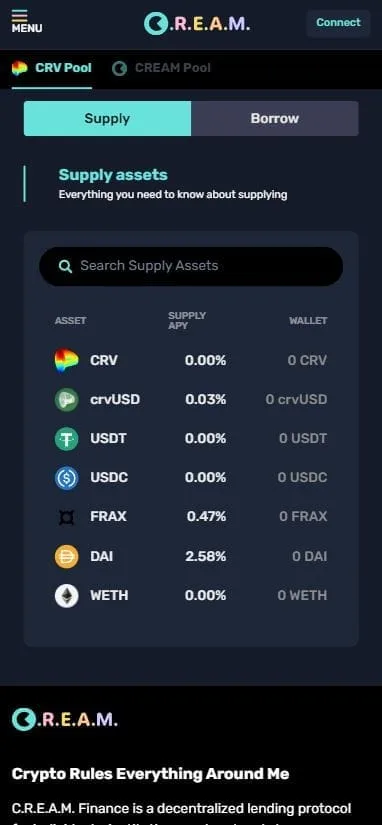What is Cream Finance?
Cream Finance is a multi-purpose decentralized finance (DeFi) protocol that operates on multiple blockchain networks, enabling users to participate in peer-to-peer cryptocurrency lending and borrowing, as well as staking and liquidity mining. The platform, which is a fork of Compound Finance, aims to offer a broader selection of crypto assets, including less-established, high-potential cryptocurrencies that are often underserved by other platforms.
Cream Finance also features a native token called CREAM, which is used for governance, staking, and sharing a portion of the platform’s transaction fees.

Key Features of Cream Finance
- Lending and Borrowing:
- Lending: Users can lend their cryptocurrencies into liquidity pools and earn interest. The assets are represented by cTokens (similar to Compound), such as cETH or cDAI.
- Borrowing: Users deposit collateral in the form of crypto to borrow other assets. The loan amount is limited by a collateralization ratio, which ensures the loan does not exceed a certain percentage of the collateral’s value. Borrowers must maintain this ratio to avoid liquidation if the collateral’s value falls.
- Iron Bank (v2): Launched in 2021, the Iron Bank allows protocol-to-protocol lending, meaning whitelisted protocols can borrow funds without providing collateral. Currently, the list of approved protocols includes Yearn Vaults and Alpha Homora.
- Staking and Liquidity Mining:
- CREAM Staking: Users can stake CREAM tokens to earn a return based on the duration of their stake. This provides a way to earn passive income, but with the risk that if the price of CREAM falls, the investor may still incur a loss despite staking.
- Boosted Savings: Introduced in 2021, this feature allows users to earn higher annual percentage yields (APY) by automating the delegation of assets for staking. It initially applies to BNB deposits on the Binance Smart Chain (BSC), with plans to expand to other blockchains.
- Governance and Economic Rights:
- CREAM Token: The native token of the protocol, CREAM is an ERC-20 token. It is used for governance, meaning holders can vote on protocol upgrades or changes. Additionally, users who hold CREAM tokens can earn a share of the transaction fees on the platform (specifically 0.05% of the 0.25% fee on token swaps).
- Governance: Through governance, CREAM token holders can influence decisions related to the protocol’s future, such as fee structures, collateral requirements, and the addition of new assets.
- Cross-Chain Operations:
- Cream Finance launched initially on Ethereum (ETH) and then expanded to Binance Smart Chain (BSC), Fantom (FTM), and Polygon (MATIC). Each of these platforms offers users lower gas fees, faster transactions, and access to additional liquidity and markets.
How Does Cream Finance Work?
1. Lending and Borrowing
- Lenders: Users deposit crypto assets into Cream Finance’s liquidity pools. In return, they receive cTokens, representing their deposits. These cTokens can be traded or redeemed for the original assets plus interest.
- Borrowers: To borrow from Cream Finance, users must first deposit collateral (crypto assets) into the protocol. They can then borrow up to a certain percentage of the value of the collateral. If the value of the collateral drops below the required threshold, the protocol may automatically liquidate the collateral to cover the borrowed amount.
- Interest Rates: The interest rates on borrowing and lending are algorithmically set based on supply and demand within each market. If more people are lending a particular asset, the interest rates for borrowing that asset will decrease, and vice versa.
- Iron Bank (v2): In March 2021, Cream Finance introduced Iron Bank, a protocol-to-protocol lending platform that allows well-established protocols to borrow funds without collateral. Whitelisted protocols like Yearn Vaults can access liquidity this way, creating new opportunities for liquidity providers.
2. Staking
- CREAM Staking: CREAM token holders can stake their tokens in Cream Finance to earn rewards. The longer the tokens are staked, the higher the potential returns. However, staking comes with risks, particularly market volatility, which could lead to losses if the price of CREAM drops significantly.
3. Boosted Savings
- Boosted Savings: This feature allows users to earn higher APYs through automated delegation. When users deposit certain cryptocurrencies, such as BNB on BSC, their tokens are automatically delegated for staking, and they earn rewards from both the lending interest and validator rewards.
4. Governance
- CREAM Governance: CREAM token holders can vote on proposals related to protocol upgrades, the addition of new assets, or changes to the fee structure. This decentralized governance model ensures that the community has a say in the protocol’s development.

Who Created Cream Finance?
Cream Finance was co-founded by Jeffrey Huang and Leo Cheng.
- Jeffrey Huang:
- Jeffrey Huang is a Taiwanese serial entrepreneur and businessman. He is the founder of Mithril (a social media platform built on Ethereum) and co-founder of Machi X (a platform for tokenized digital art). Huang has extensive experience in tech startups and blockchain projects.
- Leo Cheng:
- Leo Cheng is the co-founder and project lead at Cream Finance. He holds a Bachelor of Arts in Economics from the University of California, Berkeley (UCB), and an MBA from the University of Michigan. Cheng has a background in business management and has worked for major companies such as Applied Materials, Apple, American Express, and Belkin. Before Cream Finance, he also co-founded Blockstate, a company offering blockchain consulting services.
Why Use Cream Finance?
- Wide Range of Supported Assets: Cream Finance supports a broad range of crypto assets, including high-risk, high-reward tokens that are not supported by other DeFi protocols. This enables users to gain liquidity and earn interest on these underrepresented assets.
- Cross-Chain Capabilities: By operating across multiple blockchains (Ethereum, BSC, Fantom, Polygon), Cream Finance offers greater accessibility, lower fees, and faster transactions than many other DeFi platforms.
- Protocol-to-Protocol Lending (Iron Bank): The Iron Bank feature introduces a new model of collateral-free borrowing for whitelisted protocols, which could further expand liquidity in the DeFi ecosystem.
- Governance and Fee Sharing: Cream Finance offers governance rights to token holders, allowing them to influence protocol decisions. Additionally, users can earn a portion of the fees generated by the platform through governance.
- Passive Income via Staking: Users can stake CREAM tokens and earn rewards, providing an opportunity for passive income.




















Zulu –
Ray Dalio invests into cream finance
Nectarine –
Definitely joining!